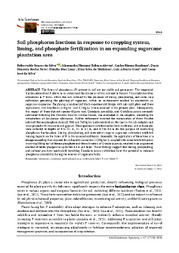Soil phosphorus fractions in response to cropping system, liming, and phosphate fertilization in an expanding sugarcane plantation area.
Soil phosphorus fractions in response to cropping system, liming, and phosphate fertilization in an expanding sugarcane plantation area.
Autoria: SILVA, R. S. da; ALOVISI, A. M. T; KURIHARA, C. H.; ROCHA NETO, D. P.; LIMA, N. D.; MEDEIROS, E. S. de; STAUT, C. A.; SILVA, C. J. da.
Resumo: The forms of phosphorus (P) present in soil are not stable and permanent. The sequential fractionation of soil P allows us to understand the dynamics of this nutrient in the soil. This study identifies alterations in P forms within the soil, induced by the processes of liming, phosphating, and cover crop cultivation preceding the planting of sugarcane, within an environment marked by constraints on sugarcane expansion. Employing a randomized block experimental design with sub-split plots and three replications, two lime doses (6 Mg ha-1 and 12 Mg ha-1 ) were assessed in the primary plots. Subsequently, the impact of three distinct species-Glycine max, Crotalaria spectabilis, and Crotalaria juncea remnant- cultivated following the Urochloa brizanta cultivar Xaraés, was evaluated in the subplots, preceding the introduction of Saccharum officinarum. Further refinement involved the examination of three Phosfaz calcined thermophosphate doses (0, 380, and 760 kg ha-1 ) administered on the spot in the sub-subplots and incorporated with limestone and gypsum. The experiment unfolded under field conditions, and soil samples were collected at depths of 0 to 0.1 m, 0.1 to 0.2 m, and 0.2 to 0.4 m for the purpose of conducting phosphorus fractionation. Liming, phosphating, and antecedent crops to sugarcane cultivation exhibited varying impacts on the forms of P in the assessed soil layers. Generally, the application of limestone at a dosage exceeding that required for soil acidity correction (12 Mg ha-1 ), coupled with corrective fertilization involving 380 kg ha-1 of thermophosphate and the cultivation of Crotalaria juncea, resulted in an augmented content of labile phosphorus up to the 0.4 m soil layer. These findings suggest that liming, phosphating, and cultural practices-particularly involving Crotalaria juncea cultivation-have the potential to enhance phosphorus availability during the renewal of sugarcane fields.
Ano de publicação: 2025
Tipo de publicação: Artigo de periódico
Unidade: Embrapa Agropecuária Oeste
Palavras-chave: Sistemas integrados
Observações
1 - Por padrão são exibidas publicações dos últimos 20 anos. Para encontrar publicações mais antigas, configure o filtro ano de publicação, colocando o ano a partir do qual você deseja encontrar publicações. O filtro está na coluna da esquerda na busca acima.
2 - Para ler algumas publicações da Embrapa (apenas as que estão em formato ePub), é necessário ter, no celular ou computador, um desses softwares gratuitos. Sistemas Android: Google Play Livros; IOS: iBooks; Windows e Linux: software Calibre.
Acesse outras publicações
Acesse a Base de Dados da Pesquisa Agropecuária (BDPA) para consultar o acervo completo das bibliotecas da Embrapa.

